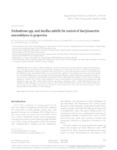Use este identificador para citar ou linkar para este item:
http://www.alice.cnptia.embrapa.br/alice/handle/doc/1063977Registro completo de metadados
| Campo DC | Valor | Idioma |
|---|---|---|
| dc.contributor.author | SANTOS. R. F. dos | pt_BR |
| dc.contributor.author | HECKLER, L. I. | pt_BR |
| dc.contributor.author | LAZAROTTO, M. | pt_BR |
| dc.contributor.author | GARRIDO, L. da R. | pt_BR |
| dc.contributor.author | REGO, C. | pt_BR |
| dc.contributor.author | BLUME, E. | pt_BR |
| dc.date.accessioned | 2017-02-14T11:11:11Z | pt_BR |
| dc.date.available | 2017-02-14T11:11:11Z | pt_BR |
| dc.date.created | 2017-02-14 | pt_BR |
| dc.date.issued | 2016 | pt_BR |
| dc.identifier.citation | Phytopathologia Mediterranea, v. 55, n. 2, p. 293− | pt_BR |
| dc.identifier.citation | 300, 2016. | eng |
| dc.identifier.uri | http://www.alice.cnptia.embrapa.br/alice/handle/doc/1063977 | pt_BR |
| dc.description | Black foot disease, which is primarily caused by Dactylonectria species, affects young and mature grapevines, causing loss of productivity and reduction of longevity of vineyards. Because it is a soil-borne fungus, this pathogen offers limited control possibilities. This study aimed to assess the biocontrol activity of products based on Trichoderma spp. and Bacillus subtilis, in vitro and in vivo, against D. macrodidyma. In vitro assays were carried out to evaluate inhibition of mycelial growth of the pathogen through volatile metabolites and paired cultures assays. An in vivo experiment evaluated the potential biocontrol of the pathogen in plants of Vitis vinifera cv. Merlot, grafted on "Paulsen 1103". In the volatile metabolites assay, mean inhibition of mycelial growth in treatments using Trichoderma spp. was 59%. In the paired cultures experiment, treatment with B. subtilis (Rizolyptus®) gave 41% inhibition of the pathogen. In the in vivo assay, the best results for length of the primary shoots, total numbers of nodes and root dry weight were achieved with the B. subtilis treatments. This study demonstrates that B. subtilis has potential for biocontrol of D. macrodidyma. Key words: Vitis vinifera, black foot disease, soil-borne pathogen, biological control. Key words: Vitis vinifera, black foot disease, soil-borne pathogen, biological control. | pt_BR |
| dc.language.iso | eng | eng |
| dc.rights | openAccess | eng |
| dc.subject | Black foot disease | pt_BR |
| dc.subject | Soil-borne pathogen | pt_BR |
| dc.title | Trichoderma spp. and Bacillus subtilis for control of Dactylonectria macrodidyma in grapevine. | pt_BR |
| dc.type | Artigo de periódico | pt_BR |
| dc.date.updated | 2019-05-06T11:11:11Z | pt_BR |
| dc.subject.thesagro | Vitis Vinifera | pt_BR |
| dc.subject.nalthesaurus | biological control | pt_BR |
| riaa.ainfo.id | 1063977 | pt_BR |
| riaa.ainfo.lastupdate | 2019-05-06 -03:00:00 | pt_BR |
| dc.contributor.institution | Ricardo Feliciano dos SANTOS, 1 Universidade de São Paulo, Escola Superior de Agricultura “Luiz de Queiroz”, Departamento de Fitopatologia e Nematologia, Laboratório de Epidemiologia, 13418-900 Piracicaba, Brazil; Leise Inês HECKLER, 2 Universidade Federal de Santa Maria, Centro de Ciências Rurais, Departamento de Defesa Fitossanitária, Laboratório de Fitopatologia, 97105-900 Santa Maria, Brazil; Marília LAZAROTTO, Universidade Federal do Rio Grande do Sul, Departamento de Horticultura e Silvicultura, Laboratório de Horticultura e Silvicultura, 91501-970 Porto Alegre, Brazil; LUCAS DA RESSURREICAO GARRIDO, CNPUV; Cecilia REGO, Universidade de Lisboa, Instituto Superior de Agronomia, LEAF, Centro de Investigação em Agronomia, Alimentos, Ambiente e Paisagem, Tapada da Ajuda, 1349-017 Lisboa, Portuga; Elena BLUME, Universidade Federal de Santa Maria, Centro de Ciências Rurais, Departamento de Defesa Fitossanitária, Laboratório de Fitopatologia, 97105-900 Santa Maria, Brazil. | pt_BR |
| Aparece nas coleções: | Artigo em periódico indexado (CNPUV)  | |
Arquivos associados a este item:
| Arquivo | Descrição | Tamanho | Formato | |
|---|---|---|---|---|
| 18048380041PB.pdf | 167,05 kB | Adobe PDF |  Visualizar/Abrir |









